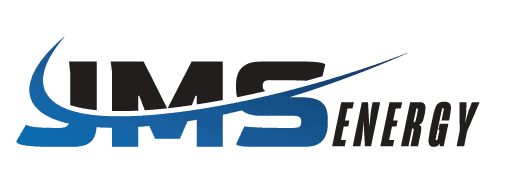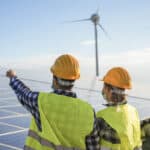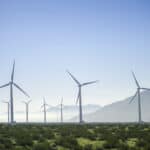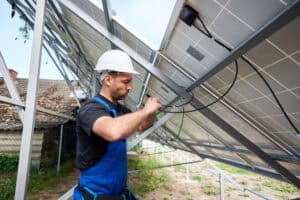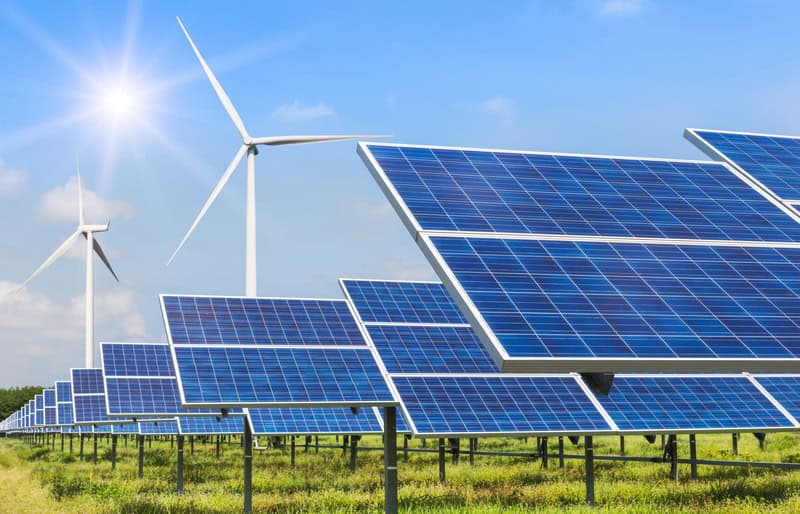
Table of Contents
Renewable energy has become a critical component in the transition toward a sustainable future. Among the various renewable energy sources, wind turbines and solar power are the two most popular and widely adopted, and as such, the “Wind Turbine vs Solar Power” debate has become a central issue to many looking to contribute to the green energy transition. While both technologies offer a path to reducing carbon emissions and energy costs, they come with unique benefits and challenges.
But what if you could maximize the advantages of both energy sources? That’s where JMS Energy comes in. As a leader in renewable energy solutions, JMS Energy specializes in optimizing wind and solar power generation to enhance efficiency, lower costs, and ensure sustainable energy production so that it’s no longer “Wind Turbine vs Solar Power”, but instead Wind Turbines AND Solar Power.
In this article, we will explore the key points of the wind turbine vs solar power debate, discuss their pros and cons, and highlight how partnering with JMS Energy can create a powerful synergy between the two.
Understanding Wind Turbines
How Do Wind Turbines Work?
To understand the Wind Turbine vs Solar Power debate, one should first grasp how both systems work. Wind turbines generate electricity by converting kinetic energy from the wind into mechanical power. Here’s how the process works:
- Wind Blows Over the Blades – The wind causes the turbine blades to spin.
- Rotational Energy Transfers to the Shaft – The spinning blades turn a rotor, which is connected to a shaft inside the turbine.
- The Generator Converts Energy into Electricity – The mechanical energy from the rotor is converted into electrical energy through a generator.
- Electricity Is Transmitted to the Grid – The generated electricity flows through transmission lines and powers homes, businesses, and industries.
Advantages of Wind Turbines
Wind energy has been a dominant force in the renewable sector, contributing significantly to the global electricity supply. Some of the biggest advantages brought up in wind turbine vs solar power debates include:
High Energy Efficiency
Wind turbines can convert 45-50% of the wind’s kinetic energy into electricity, making them one of the most efficient renewable energy sources. In comparison, even the best solar panels only achieve about 20-23% efficiency.
24/7 Energy Production
Another credit often discussed in wind turbine vs solar power debates is that, unlike solar panels which can only generate electricity during daylight hours, wind turbines can operate day and night, as long as wind conditions are favorable.
Lower Carbon Footprint
Wind power is one of the cleanest energy sources, emitting almost zero carbon emissions. On average, a wind turbine releases 4.64 grams of CO₂ per kWh, whereas solar panels release 70 grams per kWh.
High Energy Output Per Square Foot
A single wind turbine can generate enough energy to power thousands of homes, making it a great choice for large-scale energy production.
Challenges of Wind Turbines
Despite their benefits, wind turbines have a few drawbacks which have made choosing a clear winner in the wind turbine vs solar power debate difficult:
Dependent on Wind Conditions
If wind speeds are too low, the turbine won’t generate electricity efficiently. If they are too high, turbines must shut down to prevent damage.
High Initial Costs
The cost of installing a large-scale wind turbine can range from $2 million to $4 million, depending on size and location.
Space Requirements
Wind farms require large, open spaces with minimal obstructions to ensure optimal wind flow. This makes them less feasible for densely populated areas, something often mentioned in wind turbine vs. solar power debates amongst discussions of urban sprawl.
Understanding Solar Power
How Do Solar Panels Work?
Solar panels work by converting sunlight into electricity using photovoltaic (PV) cells. The process is as follows:
- Sunlight Hits the Solar Panels – The PV cells absorb photons from sunlight.
- Electric Current Is Generated – The photons create an electric field, which generates direct current (DC) electricity.
- The Inverter Converts DC to AC – Since homes and businesses use alternating current (AC) electricity, an inverter converts the DC electricity into usable AC power.
- Electricity Is Distributed – The generated power is used immediately or stored in batteries for later use.
Advantages of Solar Power
Abundant and Free Energy Source
Solar power comes from the sun, which is an unlimited energy source. Unlike fossil fuels, sunlight will never run out.
Scalability
A massive credit to Solar panels in the wind turbine vs solar power debate is that they can be installed on residential rooftops, commercial buildings, and large solar farms, making them suitable for both small and large-scale energy projects.
Minimal Maintenance
Once installed, solar panels require very little maintenance. They have no moving parts, making them more durable and cost-effective over time.
Modular Design
Solar panels can be easily expanded. If more energy is needed, additional panels can be installed. This is not always feasible for wind turbines, an important facet in wind turbine vs solar power discussion.
Challenges of Solar Power
Intermittent Energy Production
Solar panels only work during daylight hours, which makes energy storage solutions essential for nighttime use.
Space Requirements
Like wind energy, generating large amounts of solar energy requires significant space, especially for utility-scale solar farms.
Lower Energy Conversion Efficiency
Most solar panels convert only 20-23% of sunlight into electricity, compared to the 45-50% efficiency of wind turbines, a fact that is often relevant in wind turbine vs solar power debates.
How JMS Energy Can Maximize the Benefits of Wind and Solar Power

With JMS, it doesn’t have to be “Wind Turbine vs Solar Power”. JMS Energy specializes in integrating wind and solar power to create the most efficient and cost-effective energy solutions. Here’s how JMS Energy can help:
1. Hybrid Energy Systems
By combining wind and solar power, JMS Energy designs custom hybrid systems that generate continuous, reliable energy even in fluctuating weather conditions.
2. Advanced Energy Storage Solutions
JMS Energy helps businesses and homeowners implement battery storage systems to store excess energy, ensuring a consistent power supply even when wind and sunlight are unavailable.
3. Expert Installation and Maintenance
With over 20 years of experience in the renewable energy industry, JMS Energy provides:
- Professional tower wiring for wind turbines
- Expert solar panel installation
- Ongoing maintenance services to maximize system efficiency
4. Cost Savings and Incentives
JMS Energy helps clients take advantage of government incentives, tax credits, and rebates for renewable energy installations, reducing upfront costs.
5. Customized Energy Solutions
Every location has unique energy needs. JMS Energy analyzes your site and designs a tailored renewable energy solution that maximizes efficiency and savings.
Conclusion: The Future of Renewable Energy with JMS Energy
Both wind turbines and solar power offer incredible benefits, but combining them creates the ultimate sustainable energy solution. With JMS Energy as your partner, you can enjoy:
Lower energy costs
Maximum efficiency with hybrid systems
Reliable power supply day and night
Reduced carbon footprint
Leave the Wind Turbine vs Solar Power debate in the past and contact JMS Energy today to get the best of both worlds.
